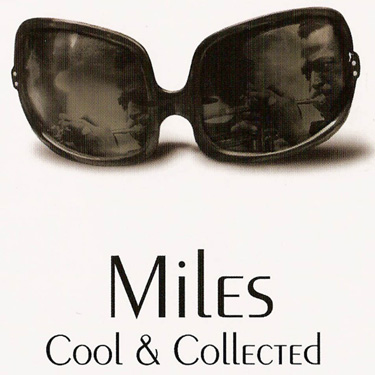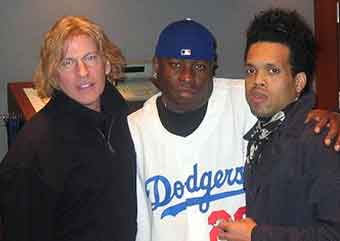|
 Featuring remixes by Pat Thrall, Vince Wilburn and Charley Drayton Featuring remixes by Pat Thrall, Vince Wilburn and Charley Drayton
LAS VEGAS, NEVADA: Artist, engineer and producer Pat Thrall is redefining the art of the remix through his work on classic recordings from the late 1960s, introducing a whole new generation to the music of Miles Davis and Sly and the Family Stone, while carefully preserving the integrity of the original tracks. Complementing the original eight-track masters with overdubs by a host of current music artists, Thrall relies heavily on Metric Halo's ChannelStrip plug-in to insure that the old and the new recordings are correctly balanced in the remix.
On the remix of "It's About That Time" from Miles Davis' landmark 1969 album, "In a Silent Way," Thrall engineered new contributions by drummer Vince Wilburn (Davis' nephew and former band member) and bass player Charley Drayton. All three musicians co-produced the remix, which also includes overdubs by Carlos Santana and others. The remix is included on "Miles Davis - Cool & Collected," released on Columbia/Legacy Jazz on September 5th.
"ChannelStrip is basically my drum sound," shares Thrall. "I use it regularly over all the drums, and have for years. I bought it when it first came out. It's really my primary plug-in for drums, and I've built up a lot of presets that I like to use."
As Thrall relates, ChannelStrip's six-band EQ helped him position Wilburn's straight-ahead, funk drum pattern in the mix with original drummer Tony Williams' busy jazz playing. "To find the space that would work for Vince's drums I had to make them brighter and smaller, so you could hear what Tony was playing. You couldn't have one giant drum kit in that dense mix and then try and try to bring Tony on top of it."
He continues, "Another thing that I like using ChannelStrip for is filtering and sweep filtering. At the beginning of the track, Vince's drums are filtered and start very bassy, then open up. That's all ChannelStrip. And you've got six bands of parametric EQ, so you can really taper it and do some wacky stuff." Unlike some other plug-ins, he notes, "The automation in ChannelStrip is fantastic, and so smooth. It's like buttah!"
ChannelStrip was also applied to Davis' trumpet track, reports Thrall. "He was recorded beautifully. It didn't need any corrective work. But because we got the track so dense I needed him to fit better. I compressed him a bit and notched out a couple of frequencies that were cutting a little hard through the mix. We added all these drum loops and sound effects. In the second half, where Carlos Santana has his guitar solo, there are all these African drummers, so the whole thing gets very dense."
Thrall frequently uses ChannelStrip's dynamics processing on snare drum tracks, especially in rock mixes. He shares a mixing tip. "I'll duplicate the snare track and have ChannelStrip over that for a heavily gated, heavily compressed and EQ'd snare that just has a lot of pop and size to it. It cuts through the mix and makes the snare more aggressive. I'll copy that snare track again and use that to key the sidechain in the compressed snare. I use that third snare as a key, and I bump it a few milliseconds ahead so it opens the gate quicker, to get the attack more clearly." Metric Halo's ChannelStrip was used extensively by artist/engineer/producer Pat Thrall (left) to remix the music of Miles Davis and Sly and the Family Stone. Metric Halo's ChannelStrip was used extensively by artist/engineer/producer Pat Thrall (left) to remix the music of Miles Davis and Sly and the Family Stone.
He has a number of different ChannelStrip compression settings saved as drum presets. "On their own they sound insane, but when you mix it in it gives the snare drum the apparent level that you really want. It sounds like the drummer is hitting it really hard. ChannelStrip just has that sound to it, a character that I really love. You want to get a little bite and a little grit."
In fact, he reveals, for many years he used ChannelStrip across the master buss because of its particular character. "It's got a certain grittiness about it. There's something about ChannelStrip that's kind of like mixing on an SSL G console - grit that's very musical and makes things sound more aggressive. I like that it has that personality."
Thrall, who first came to prominence as a guitarist with the Pat Travers Band, is comfortable working on either side of the control room glass, engineering, programming, editing or performing with a diverse range of artists, including Beyoncé, Elton John, Sean Paul, Meat Loaf, Stevie Wonder, Clay Aiken and many others. For the recently released Sly and the Family Stone remix collection, "Different Strokes By Different Folks," he also worked with Buddy Guy, John Mayer, Chuck D, D'Angelo, Isaac Hayes, Steven Tyler and Robert Randolph on three remixes.
"We used a lot of the original tracks, then edited things and made it a little more wacky and elongated," he says of the Sly Stone remixes. "I used a lot of ChannelStrip filtering on the original stuff." For example, he shares, with the final master take of "I Want To Take You Higher" nowhere to be found in the Sony vaults, parts of the band's legendary Woodstock appearance - adjusted for speed and pitch - were added to an earlier take from the session.
"It sounded good enough that we could use some of the components. The horns were playing on the original takes as well, but we used the trumpet solo from Woodstock. We had to filter out some of the vocals and fit the horns in." At the very end of the Woodstock performance the band stops and Stone encourages the audience to sing along. Says Thrall, "So I flew that in as well - there's a whole breakdown section with half a million people singing 'higher.' Art meets science." |